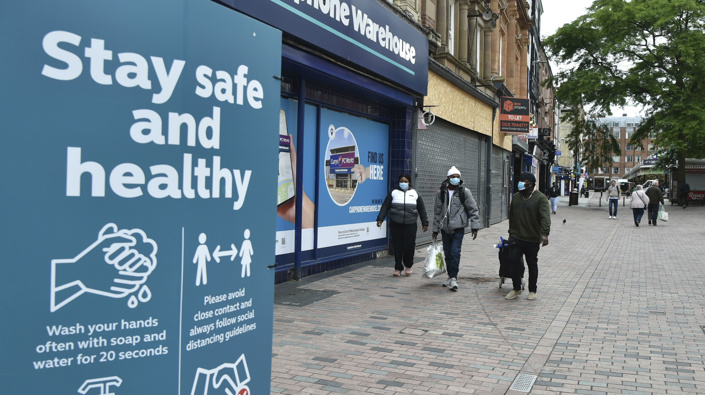Fears grew last night that new local virus lockdowns will be introduced after latest details of the worst-hit areas emerged.
Although Leicester has by far the highest rate of infection, Bradford and Barnsley in Yorkshire are also being closely monitored.
Other areas with high rates include Rochdale and Oldham in Greater Manchester and Blackburn and Darwen in Lancashire. Department of Health officials are also keeping a close eye on particular postcodes and groups of businesses which could face restrictions if infection levels do not decline.
But officials stressed that no town or area was within 24 hours of being locked down as they do not have rates as high as Leicester. Within the next few days, the department is planning to publish postcode-level data to identify exact virus hotspots – in town centres and residential areas.
Councils have had access to this information for the last ten days although the Government has been heavily criticised for not making it available far earlier.
The latest data from Public Health England up to June 27 shows that Leicester – which was placed in the first local lockdown on Monday – currently has 135.7 cases of the virus per 100,000 population. This is significantly higher than Bradford, the second worst affected, at 42.8 per 100,000 and Barnsley at 34.7. Rochdale has 31.4, Oldham 28.4, the Blackburn and Darwen council area 23.5 and Rotherham in South Yorkshire 22.3. Doncaster in South Yorkshire, Bedford and Bolton in Greater Manchester are also in the ten worst-hit boroughs, according data seen by the Mail but not yet officially published.
England’s national rate of infection’s is 6.7 per 100,000, meaning Leicester’s is 20 times higher.
The Public Health England data came after the earlier publication of a detailed breakdown, together with a map, of virus rates by local authority area for the whole country. It was based on the week up to June 21. Separate Department of Health figures show that an NHS trust in Kent has recorded more than 10 per cent of the weekly virus deaths for the whole of England.
A total of 21 patients died at East Kent Hospitals in the week to June 21, with managers attributing the number to a ‘second late peak.’
Yesterday Professor Neil Ferguson, who advised the Government before he was forced to resign for breaking lockdown rules in May, said it was ‘inevitable’ there would be more local flare-ups. He said Bradford and Doncaster were ‘clearly areas of concern’.
Speaking to BBC Radio 4’s Today Programme the scientist, of Imperial College London, added: ‘It’s inevitable we will [have further local outbreaks] – we are relaxing lockdown rules and that means that contacts in the population are going up and that’s a very variable process.’ Professor Peter Horby, of Oxford University who heads the Government’s New and Emerging Respiratory Virus Threats Advisory Group, said the public would ‘unfortunately’ need to brace themselves for further outbreaks.
He added: ‘London unfortunately led the way in the UK and now Leicester is unfortunately leading the way and we can expect more of that, so I think there will have to be local responses to local outbreaks.’ Meanwhile Labour leader Sir Keir Starmer accused the Government of being slow to act over the flare-up in Leicester.
At Prime Minister’s Questions, he claimed there had been a ‘delay of 11 days’ between Health Secretary Matt Hancock first acknowledging an outbreak in the city on June 18 and the lockdown being enforced on Monday. He asked Boris Johnson: ‘Why was the Government so slow to act?’
The Prime Minister replied that officials had sent mobile testing units to the city and ‘engaged activity with the authorities in Leicester’. He insisted: ‘We acted decisively and I think it was the right thing to do.’
Sir Keir also claimed that the Government had failed to provide Leicester council with the most up-to-date infection rates although sources insisted they had been given access to this data ten days ago but had initially chosen not to look at it.
Later the Labour leader warned that such local lockdowns could be in place throughout the summer if ministers did not improve their test and trace programme.
Addressing the Local Government Association’s virtual annual conference, he explained: ‘If we don’t get to grips with it we could be in local lockdown situations for months and months and months. It is going to be the story of the summer if we are not careful.’
Meanwhile, council and health chiefs in Barnsley insisted the town is not set to go into lockdown as the number of new cases is now falling. They said: ‘We do not believe at this stage any further measures will need to be implemented such as the ones seen in Leicester.’
Take your Radio, Podcasts and Music with you










